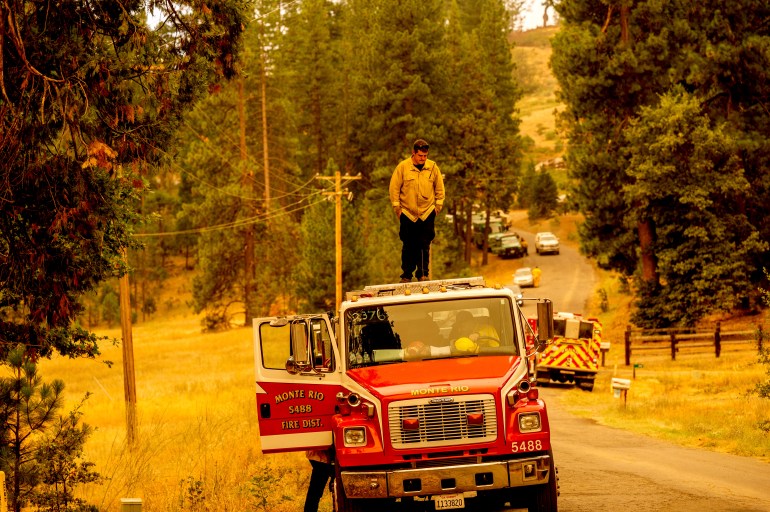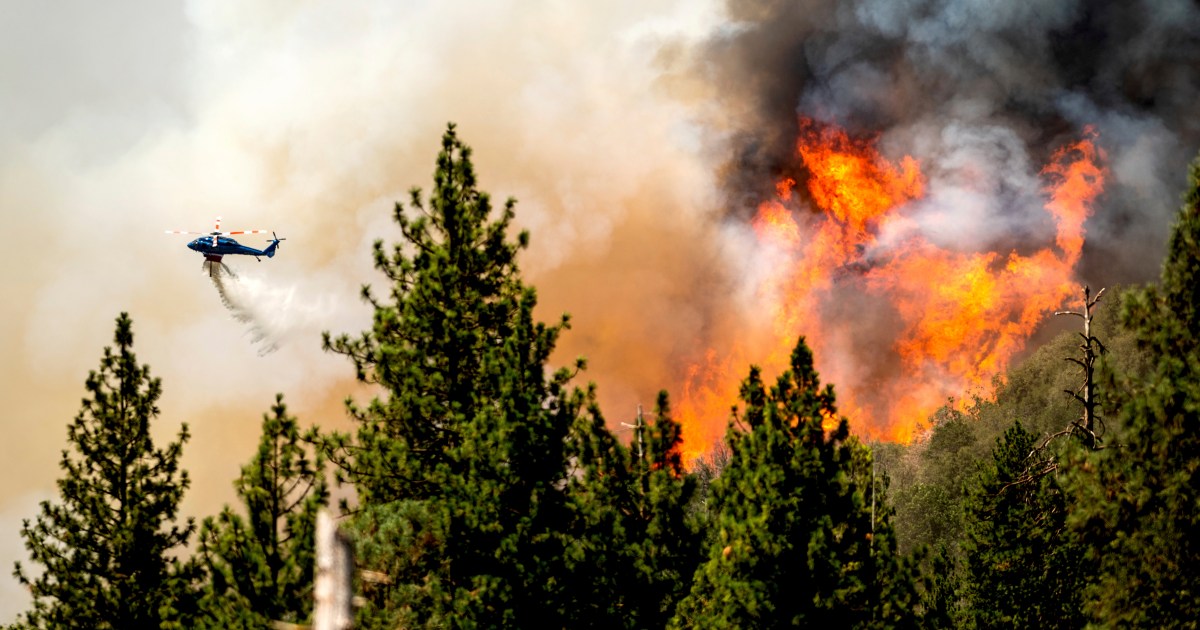[ad_1]
Firefighters have begun to slow the spread of the largest wildfire so far this year in California, after the Oak Fire threatened the famed Yosemite National Park and forced thousands of residents to evacuate their communities.
The massive blaze expanded rapidly since it began on Friday, overwhelming the initial deployment of firefighters as scorching and dry weather fuelled its galloping pace through dry forest and underbrush.
Several officials with the California Department of Forestry and Fire Protection (Cal Fire) said the fire initially behaved unlike any other they had seen, with burning embers sparking smaller fires up to 3km (2 miles) in front of the main conflagration.
But firefighters have not seen more of that so-called spotting, Cal Fire spokesperson Natasha Fouts said on Monday from the incident command centre in Merced, about 210km (130 miles) inland from San Francisco.
The absence of other major fires in the region enabled Cal Fire to concentrate 2,500 firefighters on the blaze, and the lack of wind allowed for the continuous use of aircraft to drop water and fire retardant, officials said.
“We have concentrated all our crews throughout the state here. So if there’s a silver lining, it’s that we’re throwing everything at this fire right now,” Joseph Amador, a Cal Fire spokesperson, told Al Jazeera.
The Oak Fire has engulfed 6,795 hectares (16,791 acres) and is 10 percent contained, Cal Fire said on Monday.
It is the most destructive blaze so far this fire season, destroying more than three times in area than the nearby Washburn Fire, which has been nearly 90 percent contained. But it pales in comparison with last year’s Dixie Fire, which burned nearly 405,000 hectares (1 million acres).
“What we’re seeing on this [Oak Fire] is very indicative of what we’ve seen in fires throughout California, in the West over the last two years,” Jon Heggie, a Cal Fire battalion chief, told CNN.
“These fires are burning with just such a velocity and intensity it makes it extremely challenging and extremely dangerous for both the public and the firefighters,” Heggie said.
“It’s moving so quickly it’s not giving people a lot of time and they sometimes are just going to have to evacuate with just the shirts on their back,” he said.
California Governor Gavin Newsom declared a state of emergency in Mariposa County on Saturday, citing “conditions of extreme peril to the safety of persons and property”.
In recent years, California and other parts of the western United States have been ravaged by huge and fast-moving wildfires, driven by years of drought and a warming climate.

Experts have said climate change is driving heatwaves, drought and other extreme weather conditions around the world. Virtually every part of the US has experienced above-normal temperatures in the past week, and more dangerously-hot weather is expected.
“Whatever it is, the conditions seem to be getting worse every year,” Amador at Cal Fire told Al Jazeera. “And every year we talk about record-setting years and here we are again. But we’re up to the task and we’re going to continue to do our best.”
In California, evacuations were in place Monday for more than 6,000 people living across the sparsely populated Oak Fire zone in the Sierra Nevada foothills, though a handful of residents defied the orders and stayed behind, said Adrienne Freeman, a US Forest Service spokesperson.
“We urge people to evacuate when told,” she said.
Lynda Reynolds-Brown and her husband, Aubrey, awaited news about the fate of their home from an evacuation centre at a primary school. They fled as ash rained down and the fire descended a hill towards their property.
“It just seemed like it was above our house and coming our way really quickly,” Reynolds-Brown told KCRA-TV.
High temperatures in the area on Monday were expected to reach 37C (98F) with a slight breeze throughout the day. A 20 percent chance of thunderstorms was in the forecast on Monday night and Tuesday morning, the National Weather Service said, but otherwise, the area could expect similar hot weather much of the week.
[ad_2]
Source link














